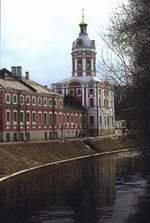|
|
|
Attractions in St. Petersburg
|  | |
THE ALEXANDER NEVSKY LAVRA
| |

| |
Alexander Nevsky Lavra ensemble is located at the end of Nevsky Prospekt, between Alexander Nevsky Square and the Obvodny Canal, at the confluence of the Monastyrka and Neva rivers; it is considered to be one of the largest architectural ensembles in St. Petersburg.
It was founded by Peter I in 1710 as the Monastery of the Holy Trinity and Saint Grand Duke Alexander Nevsky in honor of the victory over the Swedes won in 1240. In 1712—13 the first wooden Annunciation Church was put up on the left bank of the Monastyrka (or Chiornaya) River, and in 1717 construction of the monastery buildings in stone was started. In 1724 the remains of Alexander Nevsky were on Peter's order transferred from the city of Vladimir to the Blagoveshchenskaya (Annunciation) Church, newly built of stone (in 1790 the silver shrine with the relics was transferred to the Holy Trinity Cathedral).
Peter I assigned utmost importance to the monastery. The monastery trained priests of high rank for the Orthodox Church. In 1720 printing-works were established in the monastery, then a Slovenian school for middle class children, followed, in 1726, by the Slavonic, Greek and Latin Seminary and, further, by the Theological Academy. In 1797 the monastery got the lavra status.
After the revolution, in 1918, the monastery was closed down; many of the historical relics and works of art were transferred to the Hermitage, the Russian Museum and other places. In 1923 a Necropolis-Museum was established on part of the territory (since 1939 called the Museum of City Sculpture). Construction works went on all through the 19th century. The ensemble was completed by I.Starov, who was the author of the Holy Trinity Cathedral (1776-90). While directing the construction works he was at the same time renovating the adjacent territory, forming thereby a new square (named after Alexander Nevsky). He enclosed the square within a semicircle of stone walls and erected a gate-church and two houses at the entrance, thus linking the lavra ensemble with Nevsky Prospekt. The Holy Trinity Cathedral completed one of the oldest city ensembles.
Most part of the territory is taken up by the Metropolitant Garden and the cemeteries: the Lazarevskoye (18th-century Necropolis), Tikhvinskoye (Necropolis of the Men of Art) and Nikolskoye (founded in 1861) cemeteries. Many outstanding Russian men of culture, statesmen, military and public leaders were buried here.
Address: nab., reki Monastirki, 1
|
|
|
|
 |
|
 |
 |
|
|
 |
 |



